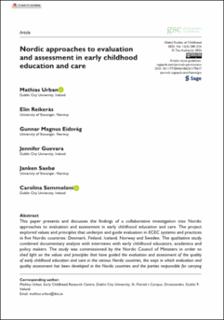| dc.contributor.author | Urban, Mathias Helmut | |
| dc.contributor.author | Reikerås, Elin Kirsti Lie | |
| dc.contributor.author | Eidsvåg, Gunnar Magnus | |
| dc.contributor.author | Jennifer, Guevara | |
| dc.contributor.author | Sæbø, Janken Camilla | |
| dc.contributor.author | Semmoloni, Carolina | |
| dc.date.accessioned | 2023-09-15T11:29:31Z | |
| dc.date.available | 2023-09-15T11:29:31Z | |
| dc.date.created | 2023-06-30T11:30:08Z | |
| dc.date.issued | 2023-06 | |
| dc.identifier.citation | Urban, M., Reikerås, E., Eidsvåg, G. M., Guevara, J., Saebø, J., & Semmoloni, C. (2023). Nordic approaches to evaluation and assessment in early childhood education and care. Global Studies of Childhood, 13(3), 200–216. | en_US |
| dc.identifier.issn | 2043-6106 | |
| dc.identifier.uri | https://hdl.handle.net/11250/3089733 | |
| dc.description.abstract | This paper presents and discusses the findings of a collaborative investigation into Nordic approaches to evaluation and assessment in early childhood education and care. The project explored values and principles that underpin and guide evaluation in ECEC systems and practices in five Nordic countries: Denmark, Finland, Iceland, Norway and Sweden. The qualitative study combined documentary analysis with interviews with early childhood educators, academics and policy makers. The study was commissioned by the Nordic Council of Ministers in order to shed light on the values and principles that have guided the evaluation and assessment of the quality of early childhood education and care in the various Nordic countries, the ways in which evaluation and quality assessment has been developed in the Nordic countries and the parties responsible for carrying out the evaluation and assessment. Central to our exploration was whether a coherent Nordic approach exists and what characteristics distinguish it from other possible models of ECEC system evaluation. This question has gained relevance in global contexts of International Large-scale Standardised Assessments in ECEC, promoted most prominently the Organisation for Economic Co-operation and Development (OECD). Our findings confirm the existence of a Nordic approach, consisting of a shared and coherent understanding of the underpinning values, the purpose and the appropriate methodologies across several dimensions of comparison between countries as well as within countries. Shared values and principles include well-being, child-centredness, play, learning, professionalism and reducing inequalities. Shared purpose of evaluation is to provide relevant information to improve the quality of the ECEC system. In consequence, the focus is on evaluating settings and systems that enable children to thrive, rather than assessing individual children. Nonetheless, the Nordic model must be carefully interpreted in its specific contexts. Much responsibility is delegated to the municipality level, leading to local variations and influences. More generally, we found the Nordic approaches to evaluation and assessment in ECEC firmly situated in a Nordic model of governance that emphasises decentralisation and values local democracy. We discuss the implications of this for international comparative research in ECEC, for further research into the relationship between the central and the local in ECEC and for the possibility of an explicit Nordic contribution to informing the global ECEC policy debate. | en_US |
| dc.language.iso | eng | en_US |
| dc.publisher | SAGE Publishing | en_US |
| dc.relation.uri | https://journals.sagepub.com/doi/10.1177/20436106231179617 | |
| dc.rights | Navngivelse 4.0 Internasjonal | * |
| dc.rights.uri | http://creativecommons.org/licenses/by/4.0/deed.no | * |
| dc.subject | utdanningsvitenskap | en_US |
| dc.subject | barnehagelærerutdanning | en_US |
| dc.title | Nordic approaches to evaluation and assessment in early childhood education and care | en_US |
| dc.type | Peer reviewed | en_US |
| dc.type | Journal article | en_US |
| dc.description.version | publishedVersion | en_US |
| dc.rights.holder | © The Author(s) 2023. | en_US |
| dc.subject.nsi | VDP::Samfunnsvitenskap: 200::Pedagogiske fag: 280 | en_US |
| dc.source.pagenumber | 200–216 | en_US |
| dc.source.volume | 13 | en_US |
| dc.source.journal | Global Studies of Childhood | en_US |
| dc.source.issue | 3 | en_US |
| dc.identifier.doi | 10.1177/20436106231179617 | |
| dc.identifier.cristin | 2159802 | |
| dc.relation.project | Norges forskningsråd: 275576 | en_US |
| cristin.ispublished | true | |
| cristin.fulltext | original | |
| cristin.qualitycode | 1 | |

